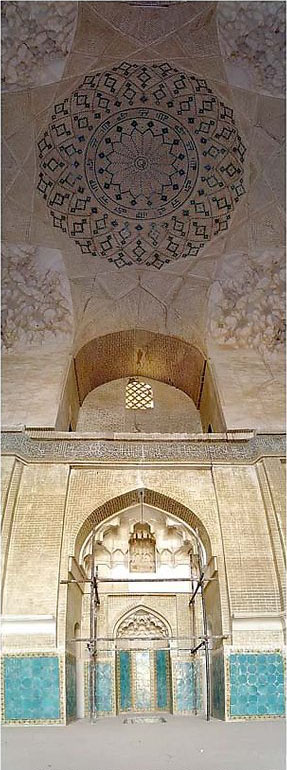Malek Mosque
| Malek Mosque (Imam Mosque of Kerman) | |
|---|---|
مسجد ملک کرمان | |
 | |
| Religion | |
| Affiliation | Islam |
| Ecclesiastical or organizational status | Mosque |
| Status | Active |
| Location | |
| Location | Kerman, Kerman Province |
| Country | Iran |
Location of the mosque in Iran | |
| Geographic coordinates | 30°17′16″N 57°4′54″E / 30.28778°N 57.08167°E |
| Architecture | |
| Type | Mosque architecture |
| Style | Seljuk |
| Funded by | Turan Shah I |
| Completed | c. 1096 CE |
| Specifications | |
| Length | 101 m (331 ft) |
| Width | 91 m (299 ft) |
| Dome(s) | One (maybe more) |
| Minaret(s) | One (squat and rounded) |
| Materials | Terracotta; bricks; stucco |
| Official name | Malek Mosque |
| Type | Built |
| Designated | 7 October 1967 |
| Reference no. | 760 |
| Conservation organization | Cultural Heritage, Handicrafts and Tourism Organization of Iran |
The Malek Mosque (Persian: مسجد ملک کرمان, romanized: Masjid-e Malik; Arabic: مسجد ملك), also called the Imam Mosque (transl. Masjid-i imam), is a mosque is located in Kerman, Iran. The mosque was built at the time of Turan Shah I, Kerman Seljuk Sultanate, between 1077 and 1096 CE, and is the biggest and oldest mosque in Kerman.[1][2]
The mosque was added to the Iran National Heritage List on 7 October 1967, administered by the Cultural Heritage, Handicrafts and Tourism Organization of Iran.
Architecture
[edit]The building has four portals. The dome at the front of the structure, the iwan behind it, and the minaret in the northeast corner are attributed to the Seljuk period. The building has been restored many time since its construction in the early part of the 11th century.[3]
There is a large sahn in the middle of the complex, containing a small pool. There are slight differences to each iwan: the iwan in the west is not as deep as others, while others are wider. Each iwan are covered by ogee vaults, surrounded by between one and four naves, including the mihrab side. The façade and interior design of the iwan in front of the mihrab significantly differs from the other iwans.[3]
The dome sits on the mihrab wall and three arches placed between two rows of rectangular pillars created by two square pillars. These are connected to each other by two small arches on the sides. Some depth was given to the mihrab by creating a corridor in front of the mihrab wall, where the mihrab wall is located. Although the building's dome in front of the mihrab is small, it is interesting in terms of its height. Transition elements in the corners of the dome are pendentive arches. The faces of the arches of the arcades and portals are decorated with glazed bricks, added at a later period.[3]
Terracotta and stucco decorations were found during 20th-century repairs, that comprise curved branches and compositions consisting of Kufic inscription bands.[3]
Gallery
[edit]-
The sahn
-
The sahn and small pool
-
The main iwan and sahn at twilight
-
Squat minaret of the mosque
-
Kufic inscription
-
The interior of the mihrab wall
-
The main Shabestan interior
-
The interior of the dome
-
The interior of the dome under different lighting conditions
-
The interior of the dome under different lighting conditions
See also
[edit]References
[edit]- ^ معرفی مسجد ملک (امام خمینی) کرمان. دانشنامه شهری ایران (in Persian). Retrieved August 15, 2019.
- ^ معرفی مسجد ملک (امام خمینی) کرمان. کجارو (in Persian). Retrieved August 15, 2019.
- ^ a b c d "Malik Mosque". Selcuklumirasi.com. 2017. Retrieved March 28, 2025.
Further reading
[edit]- Anisi, A. R. (2004). "The Masjid-i Malik in Kirman, Iran". Journal of the British Institute of Persian Studies. 42: 137–157.
- Ettinghausen, R. (1969). "Some Comments on Medieval Iranian Art". The Cambridge History of Iran. Vol. 31. Artibus Asiae. pp. 276–300.
- Schröder, E. "The Seljuq Period". A Survey of Persian Art. 2: 1033, ve fıg. 367.
External links
[edit]![]() Media related to Malek Mosque at Wikimedia Commons
Media related to Malek Mosque at Wikimedia Commons
- "Haj Agha Ali's house: a glimpse into Iran's architectural heritage". Tehran Times. October 20, 2024. Retrieved March 28, 2025.












